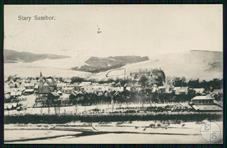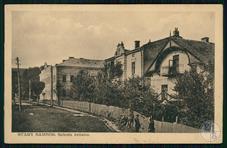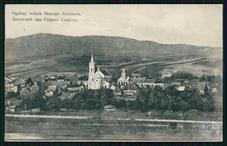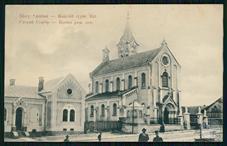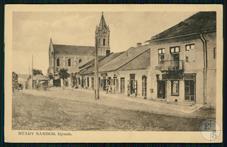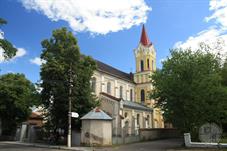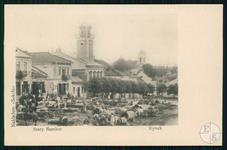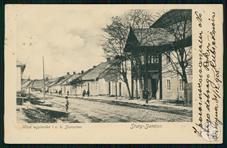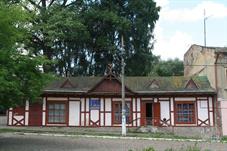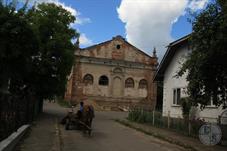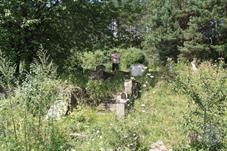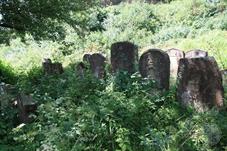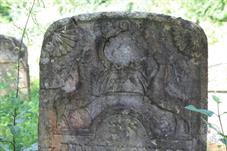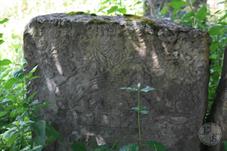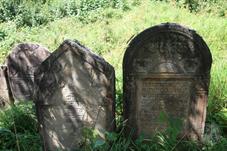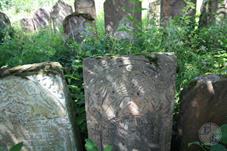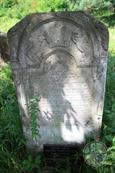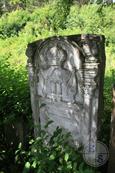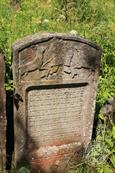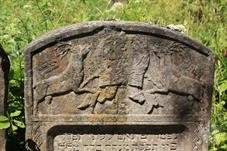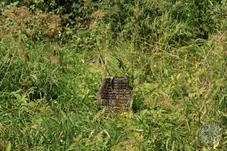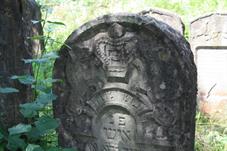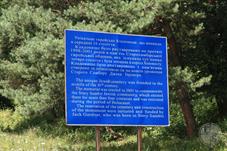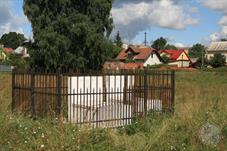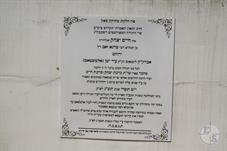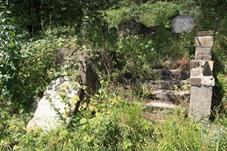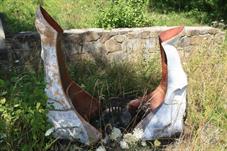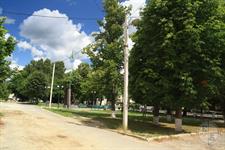Sambir district, Lviv region
Year - Total Population - Jews
1880 - 3,482 - 1,377
1890 - 3,958 - 1,613
1900 - 4,560 - 1,741
1910 - 4,931 - 1,827
1921 - 4,314 - 1,534
1931 - ? - 1,562
1880 - 3,482 - 1,377
1890 - 3,958 - 1,613
1900 - 4,560 - 1,741
1910 - 4,931 - 1,827
1921 - 4,314 - 1,534
1931 - ? - 1,562
Sources:
- Pinkas Hakehillot Polin: Encyclopedia of Jewish Communities, Poland, Volume II, page 378-379, published by Yad Vashem, Jerusalem. Translated by Jerrold Landau, JewishGen, Inc.
Photo:
- Eugene Shnaider
- Pinkas Hakehillot Polin: Encyclopedia of Jewish Communities, Poland, Volume II, page 378-379, published by Yad Vashem, Jerusalem. Translated by Jerrold Landau, JewishGen, Inc.
Photo:
- Eugene Shnaider
Staryi Sambir
The first data about Stary Sambor (Old Sambir; ukr. Staryi Sambir, Старий Самбір) is from 1425. The residents were occupied primarily in agriculture. In 1553, Stary Sambor was granted the status of a city according to the Magdeberg Charter.
The first mention of Jews of Stary Sambor is from 1544. Between 1563 and 1567, three Jews paid head tax, and the total number of Jews in the city was not more than ten. In 1569, Jews were banned from residing in the city, but some knew how to circumvent this decree. In Stary Sambor, in 1630–1631, a Jew named Yitzchak was a lessee of the land of the nobleman Danilovich who ruled the area. Some time later, the Jews Aharon the son Yaakov was noted as the lessee of the flourmill. He complained to the king about the efforts of the ruler of the district of Sambor to confiscate his property and to imprison him along with his family.
The Jewish population of the city grew from the beginning of the 18th century. They were occupied in wholesale trade of grain and other agricultural products. Retail business was also primarily in the hands of the Jews. In the 19th century, a number of sawmills and flourmills in the city and the nearby area were owned by Jews. Jewish tailors and shoemakers provided the needs of the population of the city and the area. At the end of the 19th century, the economic situation of the Jews began to worsen due to the difficult competition from the Ukrainians, who set up cooperatives and marketing unions. Many Jews left the city during the 1880s and 1890s due to the economic weakness, and they immigrated to North America.
Rabbi Yosef Gelernter occupied the rabbinical seat in 1840. Rabbi Yehoshua Goldreich served this role in the 1860s. Rabbi Nechemia Freundel served as the rabbi of the city during the 1890s. Rabbi Chaim–Yitzchak Yerucham served in this sacred role before the First World War. He was followed by Rabbi Chaim–Yaakov Horowitz.
Zionist groups were organized there at the beginning of the 20th century. At that time, the Jewish community conducted a struggle to increase its influence in the city council. There was cooperation between the Jews and the Poles, and a Jewish vice–mayor was elected in 1913.
In 1910, Hebrew courses under the auspices of Safa Berura were set up. A branch of Mizrachi was set up in Stary Sambor in 1911.
The first mention of Jews of Stary Sambor is from 1544. Between 1563 and 1567, three Jews paid head tax, and the total number of Jews in the city was not more than ten. In 1569, Jews were banned from residing in the city, but some knew how to circumvent this decree. In Stary Sambor, in 1630–1631, a Jew named Yitzchak was a lessee of the land of the nobleman Danilovich who ruled the area. Some time later, the Jews Aharon the son Yaakov was noted as the lessee of the flourmill. He complained to the king about the efforts of the ruler of the district of Sambor to confiscate his property and to imprison him along with his family.
The Jewish population of the city grew from the beginning of the 18th century. They were occupied in wholesale trade of grain and other agricultural products. Retail business was also primarily in the hands of the Jews. In the 19th century, a number of sawmills and flourmills in the city and the nearby area were owned by Jews. Jewish tailors and shoemakers provided the needs of the population of the city and the area. At the end of the 19th century, the economic situation of the Jews began to worsen due to the difficult competition from the Ukrainians, who set up cooperatives and marketing unions. Many Jews left the city during the 1880s and 1890s due to the economic weakness, and they immigrated to North America.
Rabbi Yosef Gelernter occupied the rabbinical seat in 1840. Rabbi Yehoshua Goldreich served this role in the 1860s. Rabbi Nechemia Freundel served as the rabbi of the city during the 1890s. Rabbi Chaim–Yitzchak Yerucham served in this sacred role before the First World War. He was followed by Rabbi Chaim–Yaakov Horowitz.
Zionist groups were organized there at the beginning of the 20th century. At that time, the Jewish community conducted a struggle to increase its influence in the city council. There was cooperation between the Jews and the Poles, and a Jewish vice–mayor was elected in 1913.
In 1910, Hebrew courses under the auspices of Safa Berura were set up. A branch of Mizrachi was set up in Stary Sambor in 1911.
During the time of the First World War, the Jews of Stary Sambor suffered from attacks by the Russian Army. On the eve of Rosh Hashanah 5676 (1916), a brigade of Cossacks when on a hung for Jewish women, and there was personal and property damage. There were pogroms on the Jews of Stary Sambor during the period of the Western Ukrainian Republic (1918–1919). Homes were broken into and property was pillaged. Two synagogues in the city were destroyed and holy books were desecrated during the pogroms.
At the end of the war, economic rehabilitation of communal life began. The fire that broke out in April 1923 destroyed the houses and property of 384 families. This weighed down communal life even in the following years.
With the assistance of the JOINT, workshops were built and loans were given to merchants and tradesmen. Trade courses were conducted for young people. Funds for benevolent loans began a wide ranged effort of mutual assistance.
Vibrant Zionist activity took place in Stary Sambor between the two world wars.
At the end of the war, economic rehabilitation of communal life began. The fire that broke out in April 1923 destroyed the houses and property of 384 families. This weighed down communal life even in the following years.
With the assistance of the JOINT, workshops were built and loans were given to merchants and tradesmen. Trade courses were conducted for young people. Funds for benevolent loans began a wide ranged effort of mutual assistance.
Vibrant Zionist activity took place in Stary Sambor between the two world wars.
A chapter of Beitar was established in 1930, with 80 members. The number of members reached 130 in 1933. During the 1920s, a chapter of Ezra existed, with a sports organization alongside. There were also chapters of Hashomer Hatzair and Akiba. In 1923–1924 the Jewish Union for Elementary and High Schools of Lvov conducted Hebrew courses in Stary Sambor.
No Jewish representatives were elected in several elections for the city council between the two world wars. It was only in the elections of February 1939 that three Jews were elected: two from the joint Jewish–Polish list, and one from the independent Jewish list.
In 1930, Rabbi Feivel Yerucham occupied the rabbinical seat of Stary Sambor. He was followed in 1933 by Rabbi Yeshaya–Asher HaKohen Youlis, who later perished in the Holocaust.
Units of the German army arrived in Stary Sambor and began attacking the Jews about ten days after the outbreak of war between Germany and Poland. German soldiers tortured the Jews and snatched them for forced labor. Two Jews were murdered. The Germans evacuated the city at the end of September 1939. Units of the Red Army replaced them. Hundreds of Jewish refugees from western Poland found refuge in Stary Sambor. At the end of 1939, the number of Jews approached 2,5000. Jewish political and communal activity was interrupted. A significant number of the Jewish refugees refused to receive Soviet citizenship, and were therefore deported to the interior of the Soviet Union at the end of June 1940. Jewish wholesale commerce stopped completely, and retail commerce declined in stages. Tradesmen were organized into cooperatives. A few young Jews succeeded in escaping eastward at the outbreak of the war between the Soviet Union and Germany.
No Jewish representatives were elected in several elections for the city council between the two world wars. It was only in the elections of February 1939 that three Jews were elected: two from the joint Jewish–Polish list, and one from the independent Jewish list.
In 1930, Rabbi Feivel Yerucham occupied the rabbinical seat of Stary Sambor. He was followed in 1933 by Rabbi Yeshaya–Asher HaKohen Youlis, who later perished in the Holocaust.
Units of the German army arrived in Stary Sambor and began attacking the Jews about ten days after the outbreak of war between Germany and Poland. German soldiers tortured the Jews and snatched them for forced labor. Two Jews were murdered. The Germans evacuated the city at the end of September 1939. Units of the Red Army replaced them. Hundreds of Jewish refugees from western Poland found refuge in Stary Sambor. At the end of 1939, the number of Jews approached 2,5000. Jewish political and communal activity was interrupted. A significant number of the Jewish refugees refused to receive Soviet citizenship, and were therefore deported to the interior of the Soviet Union at the end of June 1940. Jewish wholesale commerce stopped completely, and retail commerce declined in stages. Tradesmen were organized into cooperatives. A few young Jews succeeded in escaping eastward at the outbreak of the war between the Soviet Union and Germany.
The city was conquered by the Germans on July 3, 1941. The German military commander gave the Ukrainians 24 hours of “free action” against the Jews. Armed bands of Ukrainians stripped the Jewish houses. Many tens of people were injured, and 22 people were cruelly murdered in the Jewish cemetery. The slaughter in the cemetery was perpetrated in the presence of the leaders of the Ukrainian population in the city, including the priest.
Immediately after the pogrom, several decrees were imposed upon the Jews of Stary Sambor, including the wearing of a white band with a Star of David, a nightly curfew for the Jewish population only, restrictions of movement outside the city, and forced labor.
In the autumn of 1941, groups of young Jews were taken to work camps in the area. In the winter of 1941–1942, one group from Stary Sambor was taken to the Janowska Camp in Lvov.
In March 1942, a temporary ghetto was set up in the nearby city of Sambor. Part of the Jewish population of Stary Sambor was brought to that ghetto.
On August 5–6 1942, a large portion of the community of Stary Sambor was transferred to Sambor, and from there the Belzec Death Camp. Several tens of Jewish tradesmen remained in the city. They were employed by the Germans, primarily in services in the police station. In 1942, the last of the community was sent to Sambor, where they shared the fate of the Jews of that place.
Immediately after the pogrom, several decrees were imposed upon the Jews of Stary Sambor, including the wearing of a white band with a Star of David, a nightly curfew for the Jewish population only, restrictions of movement outside the city, and forced labor.
In the autumn of 1941, groups of young Jews were taken to work camps in the area. In the winter of 1941–1942, one group from Stary Sambor was taken to the Janowska Camp in Lvov.
In March 1942, a temporary ghetto was set up in the nearby city of Sambor. Part of the Jewish population of Stary Sambor was brought to that ghetto.
On August 5–6 1942, a large portion of the community of Stary Sambor was transferred to Sambor, and from there the Belzec Death Camp. Several tens of Jewish tradesmen remained in the city. They were employed by the Germans, primarily in services in the police station. In 1942, the last of the community was sent to Sambor, where they shared the fate of the Jews of that place.

- Home
- Shtetls
- Vinnytsia region
- Volyn region
- Dnipro region
- Donetsk region
- Zhytomyr region
- Zakarpattia region
- Zaporizhzhia region
- Ivano-Frankivsk region
- Kyiv region
- Kropyvnytskyi region
- Luhansk region
- Lviv region
- Mykolayiv region
- Odessa region
- Poltava region
- Rivne region
- Sumy region
- Ternopil region
- Kharkiv region
- Kherson region
- Khmelnytskyi region
- Chernihiv region
- Chernivtsi region
- Cherkasy region
- Crimea
- Synagogues
- Cemeteries
- Objects & guides
- Old photos
- History
- Contact
Jewish towns of Ukraine
Jewish towns of Ukraine
My shtetl
My shtetl
Donate
